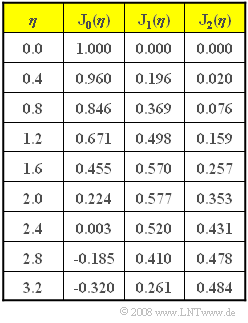Exercise 3.8: Modulation Index and Bandwidth
From LNTwww
A harmonic oscillation of the form
- $$q(t) = A_{\rm N} \cdot \cos(2 \pi \cdot f_{\rm N} \cdot t + \phi_{\rm N})$$
is angle-modulated and then the one-sided magnitude spectrum $|S_+(f)|$ is obtained.
- with a message frequency of $f_{\rm N} = 2 \ \rm kHz$ the following spectral lines can be seen with the following weights:
- $$|S_{\rm +}(98\,{\rm kHz})| = |S_{\rm +}(102\,{\rm kHz})| = 1.560\,{\rm V}\hspace{0.05cm},$$ $$|S_{\rm +}(96\,{\rm kHz})| = |S_{\rm +}(104\,{\rm kHz})| = 1.293\,{\rm V}\hspace{0.05cm},$$
- $$ |S_{\rm +}(94\,{\rm kHz})| = |S_{\rm +}(106\,{\rm kHz})| = 0.594\,{\rm V}\hspace{0.05cm}.$$
- Further spectral lines follow each with frequency spacing $f_{\rm N} = 2 \ \rm kHz$, but are not given here and can be ignored.
- If one increases the message frequency to $f_{\rm N} = 4 \ \rm kHz$, there occur dominant lines
- $$|S_{\rm +}(100\,{\rm kHz})| = 2.013\,{\rm V}\hspace{0.05cm},$$
- $$|S_{\rm +}(96\,{\rm kHz})|\hspace{0.2cm} = |S_{\rm +}(104\,{\rm kHz})| = 1.494\,{\rm V}\hspace{0.05cm},$$
- $$ |S_{\rm +}(92\,{\rm kHz})|\hspace{0.2cm} = |S_{\rm +}(108\,{\rm kHz})| = 0.477\,{\rm V},$$
- as well as further, negligible Dirac lines with spacing $f_{\rm N} = 4 \ \rm kHz$.
Hints:
- This exercise belongs to the chapter Frequency Modulation.
- Reference is also made to the chapter Phase Modulation and particularly to the section Signal characteristics with frequency modulation.
Questions
Solution
(1) We are dealing with a frequency modulation⇒ Answer 2.
- In phase modulation, the weights of the Dirac lines would not change when the frequency is doubled.
(2) The spectral function given suggests the carrier frequency $f_{\rm T} = 100 \ \rm kHz$ due to the symmetry properties.
- Since at $f_{\rm N} = 2 \ \rm kHz$ the spectral line disappears at $f_{\rm T} = 100 \ \rm kHz$ , we can assume $η_2 \hspace{0.15cm}\underline { ≈ 2.4}$ .
- A check of the other pulse weights confirms this result:
- $$\frac { |S_{\rm +}(f =102\,{\rm kHz})|}{ |S_{\rm +}(f =104\,{\rm kHz})|} = 1.206,\hspace{0.2cm} \frac { {\rm J}_1(2.4)}{ {\rm J}_2(2.4)}= 1.206 \hspace{0.05cm}.$$
(3) The weights of the Dirac lines at $f_{\rm T} + n · f_{\rm N}$ are generally:
- $$D_n = A_{\rm T} \cdot { {\rm J}_n(\eta)} \hspace{0.3cm}\Rightarrow \hspace{0.3cm} D_1 = A_{\rm T} \cdot { {\rm J}_1(\eta)}\hspace{0.3cm}\Rightarrow \hspace{0.3cm} A_{\rm T} = D_1/{\rm J}_1(η) = 1.560\ \rm V/0.520\hspace{0.15cm}\underline { = 3 \ V}.$$
(4) Given the requirement $K < 1\%$ , one can use the following rule of thumb (Carson's rule):
- $$B_{\rm 2} = 2 \cdot f_{\rm N} \cdot (\eta +2) \hspace{0.15cm}\underline {= 17.6\,{\rm kHz}}\hspace{0.05cm}.$$
- Thus, the Fourier coefficients $D_{–4}$, ... , $D_4$ are available.
(5) For frequency modulation, the general rule is:
- $$\eta = \frac{K_{\rm FM} \cdot A_{\rm N}}{ \omega_{\rm N}} \hspace{0.05cm}.$$
- Thus, by doubling the message frequency $f_{\rm N}$, the modulation index is halved: $η_4 = η_2/2\hspace{0.15cm}\underline { = 1.2}$.
(6) Using the same calculation as in question (4) , the channel bandwidth necessary for $K < 1\%$ is obtained using
- $$B_4 = 3.2 · 8\ \rm kHz \hspace{0.15cm}\underline {= 25.6 \ \rm kHz}.$$
- Because the modulation index is only half as large, transmitting the Fourier coefficients $D_{–3}$, ... , $D_3$ is sufficient for limiting the distortion factor to $1\%$.
